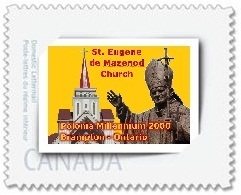


Sunday, MARCH 3, 2019, Mississauga, Ontario
XVI Polish – Canadian Coin, Stamp & Collectibles Show 2019
at John Paul II Polish Cultural Centre,
4300 Cawthra Rd. (just south of Hwy. 403). Mississauga, Ontario
SUNDAY 9 am to 4 pm with $5 adult admission. Kids 16 and under Free.
Free parking. 30+ DEALERS of CANADIAN and INTERNATIONAL Stamps, Gold
and Silver Coins, Royal Canadian Mint Coins, Paper Money, Military and
other Collectibles. Canada Post Shop.
Bring coins, stamps or collectibles to be evaluated and get best prices.
Organized by the Polish-Canadian Coin & Stamp Club (Troyak Club) …
offering free stamps for kids. Displays of Coins, Stamps, Collectibles by Guests
and Club Members. See www.troyakclub.com for details.
More information: Contact Les Plonka –
leszekp@rogers.com or call (416) 505-7999 …

TROYAK EXECUTIVE TEAM is informing all members, colleagues, collectors and Polonia at large, that Club meetings taking place at John Paul II Polish Cultural Centre, 4300 Cawthra Rd. (just south of Hwy. 403), Mississauga, Ontario. The new members are always welcome. www.polishculturalcentre.ca
ADRES SPOTKAÑ KLUBOWYCH ! Zarząd Główny Klubu “Troyak” informuje wszystkich członków kolekcjonerów, sympatyków oraz całą Polonię, że spotkania klubowe odbywają się w Polskim Centrum Kultury im. Jana Pawła II, przy 4300 Cawthra Rd. (na południe od autostrady 403), Mississauga, Ontario. Zapraszamy nowych członków do prężnego. Klubu “Troyak”. www.polishculturalcentre.ca

“TROYAK” CLUB NEXT MEETINGS …
NASTĘPNE SPOTKANIA KLUBU “TROYAK” …
3rd March 2019 …
XVI Polish – Canadian Coin, Stamp & Collectibles Show 2019
31st March 2019 @ 4:30 p.m.
28th April 2019; 26th May 2019; 23rd June 2019
July & August 2019 – Summer break … Letnie wakacje …
29th September 2019
6th October 2019 @ 9:00 a.m. to 4:00 p.m. …
Mississauga’s Coin & Stamp Show 2019
27th October 2019; 24th November 2019
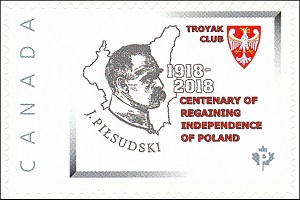
Special Medal by Consulate of Poland & Troyak Club
The idea to issue a medal for the 100th anniversary of Poland regaining its Independence started several months ago. The Consulate General of Poland in Toronto was approached to see if they would like to sponsor such medal. They agreed to cover the costs of the dies and the design. The designer, Dorothy Baniak, undertook the challenge to design a Polish-Canadian themed medal. It took few tries to become what it is now. Medal will be struck in silver and copper. The medal will be ready for distribution in February/March 2019 timeframe. Email info@troyakclub.com for information on ordering the medal, stamps or covers.
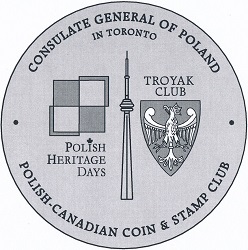
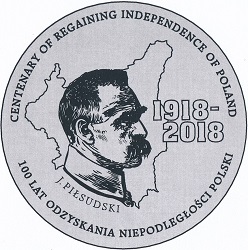
Final design of the Medal. Designer: Dorothy Baniak …
“DESIGN-Consulate-Troyak SIDE” & “DESIGN-PILSUDSKI SIDE”.
Medal specifications: Silver: 0.9999 Fine Silver 1 oz. in plastic capsule.
Copper: Alloy #110 Copper in plastic capsule.
Size: 3.30 mm x 38.00 mm dia.
Non-Member Cost: Silver $70 CAD; Copper $15 CAD.

150. rocznica urodzin Stanisława Wyspiańskiego
150th Anniversary of the Birth of Stanislaw Wyspianski
www.poczta-polska.pl

Wartość: 3,20 zł … autor projektu znaczka: Jarosław Ochendzan
liczba znaczków: 1; nakład: 120 000 szt.; technika druku: rotograwiura;
format znaczka: 31,25 x 43 mm; arkusz sprzedażny: 50 znaczków;
papier: fluorescencyjny; data wprowadzenia do obiegu: 15 stycznia 2019 r.


100. rocznica utworzenia Polskiego Czerwonego Krzyża
100th Anniversary of the creation of the Polish Red Cross
www.poczta-polska.pl
Wartość: 3,20 zł … autor projektu znaczka: Jan Konarzewski;
liczba znaczków: 1; nakład: 180 000 szt.; technika druku: offset;
format znaczka: 31,25 x 39,5 mm; arkusz sprzedażny: 12 znaczków;
papier: fluorescencyjny; data wprowadzenia do obiegu: 18 stycznia 2019 r.
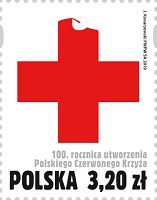
A stamp printed using offset, on fluorescent paper. Size of the stamp:
31,25 x 39,5 mm. Sales sheets contains 12 pcs. Of stamps.

100. rocznica utworzenia Polskiej Wytwórni Papierów Wartościowych
100th Anniversary of the creation of the Polish Security Printing Works
www.poczta-polska.pl
Wartość: 14,50 zł … autorka projektu znaczka: Agnieszka Próchniak;
autor rytu: Przemysław Krajewski; liczba znaczków: 1 w bloku;
nakład: 130 000 szt.; techniki druku: offset + staloryt;
format znaczka: 79 x 51 mm; format bloku: 150 x 75 mm;
papier: fluorescencyjny; data wprowadzenia do obiegu: 25 stycznia 2019 r.
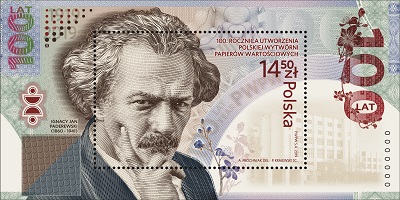
100th anniversary of the creation of the Polish Security Printing Works …
denomination: 14,50 PLN; number of stamps in set: 1 in a form of a block
print run: 130.000 pcs.; printing techniques: offset and intaglio;
paper: fluorescent; stamp size: 79 x 51 mm; block size: 150 x 75 mm;
circulation date: 25th January 2019; number of FDC: 1;
author: Agnieszka Próchniak, Przemysław Krajewski.
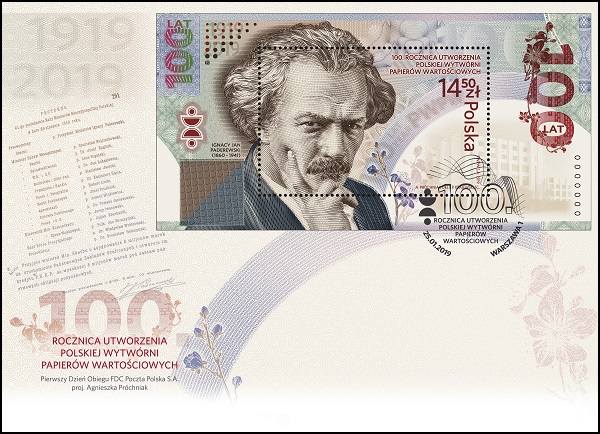
Z okazji 100. rocznicy utworzenia Polskiej Wytwórni Papierów Wartościowych Poczta Polska wyemitowała okolicznościowy znaczek z wizerunkiem Ignacego Jana Paderewskiego. Rada Ministrów kierowana przez Paderewskiego powołała Państwowe Zakłady Graficzne, poprzedniczkę PWPW, 25 stycznia 1919 roku. Rocznica powstania PWPW to także okazja, by świętować blisko 100-letnią współpracę Wytwórni z Pocztą Polską.
Autorką znaczka jest Agnieszka Próchniak, a autorem rytu – Przemysław Krajewski. Znaczek okolicznościowy w bloku został wyprodukowany w nakładzie 130 tys. sztuk. Jego wartość wynosi 14,50 zł. Jest dostępny w sprzedaży od 25 stycznia br. Na znaczku oprócz portretu Paderewskiego umieszczono także wizerunek budynku Polskiej Wytwórni Papierów Wartościowych, który został wybudowany w 1929 roku w pobliżu Starego Miasta w Warszawie. – Ignacy Jan Paderewski powiedział kiedyś, że „sprawa narodu to nie interes, z którego wycofać się należy, gdy zamiast zysków straty przynosi. Sprawa narodu to praca ciągła, praca stała, wytrwałość niezłomna, ofiarność nieprzerwana z pokolenia na pokolenie. Zaniechać jej nigdy nie wolno, a łożyć na nią, w miarę możności, zawsze się powinno”. Słowa te były aktualne zarówno 100 lat temu, jak i dziś. Polska Wytwórnia Papierów Wartościowych ma powody do dumy. Codziennie, niemal w każdej minucie jej produkty towarzyszą naszym rodakom – mówi Maciej Biernat, prezes Zarządu Polskiej Wytwórni Papierów Wartościowych.
Postać Ignacego Jana Paderewskiego została przedstawiona techniką stalorytu, na bloku ze znaczkiem znajduje się także element zbudowany z reliefu z pogrubioną linią w offsecie, fragmenty wydrukowane specjalną farbą OVI®, gilosz offsetowy, obraz wielotonalny o zmiennej grubości warstwy farby, efekt kątowy w stalorycie oraz tło ze specjalnego rastra. Dodatkowymi „smaczkami” znaczka są mikroteksty pozytywowe i negatywowe, wykonane ze zmienną wysokością liter w offsecie, a także w stalorycie. Te jednak ujawniają się dopiero pod lupą. Każdy blok zawiera także numerację typograficzną. – Ta emisja ma szczególne znaczenie zarówno dla Poczty Polskiej, jak i dla Polskiej Wytwórni Papierów Wartościowych. PWPW jest jednym z naszych największych i najstarszych partnerów, a na pewno najważniejszym w obszarze filatelistyki. To właśnie Wytwórnia drukuje od lat nasze znaczki. Dlatego tak bardzo cieszy nas fakt, że znaczek tej emisji jest tak wyjątkowy. Każdy blok ma unikatowy numer, a w samym znaczku zawarte jest wiele detali drukarskich, które mogą zainteresować nie tylko filatelistów – mówi Wiesław Włodek, wiceprezes Zarządu Poczty Polskiej.
Polska Wytwórnia Papierów Wartościowych to jedna z najważniejszych polskich instytucji. Jej historia związana jest z odzyskiwaniem przez Polskę niepodległości. Rząd polski chciał, by produkcja banknotów oraz dokumentów wzmocniła niezależność państwa. Polityka ta miała być także istotnym elementem odbudowanej tożsamości Polski. Pierwszy banknot o nominale 100 marek polskich z wizerunkiem Tadeusza Kościuszki trafił na rynek w 1920 roku. 25 stycznia 1999 roku patronem firmy obrano Ignacego Jana Paderewskiego. Początki współpracy Poczty Polskiej z Polską Wytwórnią Papierów Wartościowych sięgają 1920 roku. Wówczas Państwowe Zakłady Graficzne wyprodukowały swój pierwszy znaczek pocztowy: Orzeł na tarczy barokowej. Spośród wielu znaczków wyprodukowanych w kolejnych latach przez PWPW dla Poczty Polskiej należy wspomnieć o tych najbardziej niezwykłych: 400-lecie Poczty Polskiej (projekt: Hanna Przeździecka, ryt: Stefan Łukaszewski, data emisji – 12 grudnia 1958 r.), Ślady polskie w Europie(projektant: Kazimierz Bulik, data emisji – 16 listopada 2009 r.), Kanonizacja papieża Jana Pawła II (projektanci: Marzanna i Jacek Dąbrowscy, data emisji – 2 kwietnia 2014), Zabytkowe organy w Polsce (projektantka: Marzanna Dąbrowska, data emisji – 16 września 2017 r.)

Skarby Stanisława Augusta – Stefan Batory
www.nbp.pl
Skarby Stanisława Augusta … Wyjątkowa seria złotych i srebrnych monet kolekcjonerskich o nominałach 500 zł i 50 zł – „Skarby Stanisława Augusta” – odwzorowuje słynną osiemnastowieczną serię medalierską z wizerunkami królów Polski wykonaną na zlecenie Stanisława Augusta Poniatowskiego. Królewskie medale powstawały w mennicy warszawskiej w latach 1791–1797/1798. Ich twórcami byli dwaj wybitni medalierzy Jan Filip Holzhaeusser i Jan Jakub Reichel. Medale były wzorowane na portretach namalowanych w latach 1768–1771 przez Marcella Bacciarellego do Pokoju Marmurowego w Zamku Królewskim w Warszawie. Monety emitowane przez Narodowy Bank Polski są wiernymi replikami medali, zachowują średnicę i wysokość reliefu oryginałów. Dotyczy to portretów królewskich prezentowanych na rewersach monet.
Odwrotne strony medali z życiorysami królów, umieszczone na awersach monet, zostały pomniejszone, ponieważ towarzyszy im otok z nazwą państwa, godłem Rzeczypospolitej, nominałem oraz rokiem emisji. Życiorysy monarchów, jak również napisy na awersach medali towarzyszące portretom władców, zredagowane są po łacinie. Ostatecznej redakcji tych tekstów dokonał zapewne sam król Stanisław August. Imiona monarchów w języku polskim umieszczone zostały na boku monet; tamże znajduje się nazwa serii „Skarby Stanisława Augusta”. Poczet królów polskich wykonany na zlecenie Stanisława Augusta Poniatowskiego składał się z wizerunków 23 monarchów. Był tu o jeden portret królewski więcej niż na obrazach Bacciarellego, którego cykl obejmuje 22 obrazy. Dodatkowy portret Stanisława Leszczyńskiego, umieszczony na medalu, powstał najprawdopodobniej na podstawie obrazu Jana Bogumiła Plerscha.
Obie serie, malarska i medalierska, zaczynają się od Bolesława Chrobrego, a kończą wizerunkiem Augusta III Sasa. W Pokoju Marmurowym od XVIII wieku naczelne miejsce zajmuje jednak kilkakrotnie większy od pozostałych królewskich portretów wizerunek Stanisława Augusta w pełnej postaci, w stroju koronacyjnym. Zapewne więc i serię medalierską zamykać miał medal z wizerunkiem aktualnie panującego monarchy. Abdykacja, emigracja i rychła śmierć króla w początku 1798 r. uniemożliwiły realizację tego zamierzenia. Seria monet „Skarby Stanisława Augusta” obejmuje 24 wizerunki monarchów – 23 z oryginalnej serii królewskiej oraz portret Stanisława Augusta, odtworzony według medali z epoki. Tak jak w XVIII wieku medale, monety będą bite w złocie i w srebrze. Informacja: Tomasz Bylicki, starszy kustosz Muzeum Historyczne m. st. Warszawy.
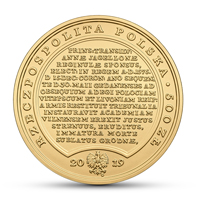
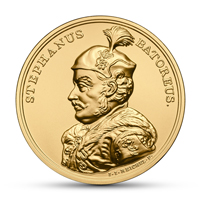
Nominał 500 zł … metal: Au 999,9/1000; stempel: zwykły;
średnica: 45 mm; masa: 62,2 g; napis na obrzeżu:
SKARBY STANISŁAWA AUGUSTA * STEFAN BATORY *
nakład: do 600 szt.; Projektant rewersu – Anna Wątróbska-Wdowiarska;
Projektant awersu oraz napisów na rewersie – Robert Kotowicz;
Na zlecenie NBP monetę wyprodukowała Mennica Polska S.A.
Emisja: 17 stycznia 2019 r.
Książę Siedmiogrodu, królewny Anny Jagiellonki małżonek, wybrany na króla Roku Pańskiego 1575 dnia 15 grudnia, koronowany w roku następnym dnia 30 maja, Gdańszczan zmusił do posłuszeństwa, Połock, Witebsk iInflanty orężem przywrócił Rzeczypospolitej, ustanowił trybunały, założył Akademię Wileńską, sprawiedliwy, waleczny, wykształcony, przedwczesną śmiercią porwany w Grodnie Roku Pańskiego 1586, w 54. roku życia, w 11. roku panowania, dnia 12 grudnia.


Nominał 50 zł … metal: Ag 999/1000; stempel: zwykły;
średnica: 45 mm; masa: 62,2 g; napis na obrzeżu:
SKARBY STANISŁAWA AUGUSTA * STEFAN BATORY *
nakład: do 5500 szt.; Projektant rewersu – Anna Wątróbska-Wdowiarska;
Projektant awersu oraz napisów na rewersie – Robert Kotowicz;
Na zlecenie NBP monetę wyprodukowała Mennica Polska S.A.
Emisja: 17 stycznia 2019 r.
Stefan Batory (1576–1586) … Piętnasta moneta serii przedstawia Stefana Batorego (Báthory István), syna wojewody siedmiogrodzkiego, od 1571 r. księcia Siedmiogrodu, 15 grudnia 1575 r. okrzykniętego przez szlachtę królem polskim. 1 maja 1576 r. poślubił Annę Jagiellonkę, wybraną rok wcześniej na króla Polski, dzięki czemu zyskał prawo do tronu i został koronowany w Krakowie. Uznaje się go za jednego z wybitniejszych władców polskich. Na rewersie monety widnieje odwzorowane z medalu popiersie króla (według obrazu pędzla Marcella Bacciarellego) profilem w lewo, z wąsami, w magierce z kitą, w żupanie i w delii z futrzanym kołnierzem i guzami, spiętej okrągłą agrafą. Na awersie monety czytamy nieznacznie skrócony tekst z rewersu medalu (w tłumaczeniu): Książę Siedmiogrodu, królewny Anny Jagiellonki małżonek, wybrany na króla Roku Pańskiego 1575 dnia 15 grudnia, koronowany w roku następnym dnia 30 maja, Gdańszczan zmusił do posłuszeństwa, Połock, Witebsk i Inflanty orężem przywrócił Rzeczypospolitej, ustanowił trybunały, założył Akademię Wileńską, sprawiedliwy, waleczny, wykształcony, przedwczesną śmiercią porwany w Grodnie Roku Pańskiego 1586, w 54. roku życia, w 11. roku panowania, dnia 12 grudnia.
Stefan Batory urodził się w 1533 r. Otrzymał staranne wykształcenie w Austrii, na dworze Habsburgów, i we Włoszech. Na Węgrzech brał udział w walkach przeciwko okupującym kraj Turkom i Habsburgom. Jako władca Polski dążył do wzmocnienia władzy królewskiej. Po objęciu tronu zmusił do uległości stronników cesarza Maksymiliana II Habsburga, kontrkandydata do korony. W 1577 r. zwyciężył wojska najemne Gdańska, optującego za Habsburgiem. Gdańsk utrzymał jednak całkowitą autonomię za cenę uznania elekcji i przyznania królowi połowy opłat nakładanych na statki i towary, które trafiały do portu (cło palowe). Szczególne zasługi Batory położył w dziedzinie wojskowości, m.in. zorganizował piechotę wybraniecką. Przeprowadził zwycięskie kampanie przeciwko Moskwie, zdobywając Połock i Wielkie Łuki. Rozejmem w Jamie Zapolskim (1582) umocnił panowanie Rzeczypospolitej w Inflantach i rozszerzył granice Litwy. Planował stworzenie ligi antytureckiej, opartej na współdziałaniu państw europejskich, w celu wyzwolenia Węgier. W polityce wewnętrznej usprawnił system podatkowy i założył nowe mennice. Powołał też nowe Trybunały – Koronny (1578) i Litewski (1581). W 1579 r. utworzył Akademię w Wilnie. Cechowała go tolerancja religijna. Zmarł w 1586 r. Został pochowany na Wawelu, gdzie w kaplicy Mariackiej umieszczono jego nagrobek dłuta Santi Gucciego. Informacja: Marta Męclewska.
Narodowy Bank Polski jest centralnym bankiem państwa odpowiadającym za politykę pieniężną i stabilność cen. Jego funkcje określa Konstytucja Rzeczypospolitej Polskiej i ustawa o NBP. NBP ma wyłączne prawo emisji pieniądza. Jako bank centralny nie prowadzi rachunków bankowych obywateli, nie przyjmuje od nich lokat, ani nie udziela kredytów. Prowadzi natomiast obsługę budżetu państwa, a także podmiotów sektora finansów publicznych. Gromadzi rezerwy walutowe państwa i zarządza nimi. Pełni funkcję banku banków, tworząc warunki dla działania system bankowego. Jest również jednym z najważniejszych ośrodków naukowo-analitycznych w dziedzinie ekonomii i rynków finansowych.

Treasures of Stanislaw August – Stephen Bathory
www.nbp.pl
Treasures of Stanisław August … The unique series of gold and silver collector coins with the face values of 500 zloty and 50 zloty – “TREASURES OF STANISŁAW AUGUST” – replicates the famous 18th century medallic series with the images of the kings of Poland, which was struck on the order of Stanisław August Poniatowski. The royal medals, designed by two outstanding medallists: Jan Filip Holzhaeusser and Jan Jakub Reichel, were struck at the Warsaw mint in the years 1791–1797/1798. The design of the medals was based on portraits painted between 1768 and 1771 by Marcello Bacciarelli for the Marble Room at the Royal Castle in Warsaw. The coins issued by Narodowy Bank Polski are faithful replicas of the medals, preserving the diameter and height of relief of the originals. This applies to the portraits of the kings on the reverses. The obverses of the coins feature the reverses of the medals with biographies of the monarchs. The reverses of the medals have been reduced in size because they are accompanied by the name of the state along the rim, the image of the state emblem, the face value and the year of issue of the coins. The biographies of the monarchs and the inscriptions on the obverses of the medals accompanying the royal portraits are in Latin. The final text editing was most likely done by King Stanisław August himself. The names of the monarchs in Polish are presented on the sides of the coins, along with the name of the series “Treasures of Stanisław August”.
The gallery of portraits of Polish kings, painted on the order of Stanisław August Poniatowski, consisted of images of 23 monarchs. It included one royal portrait more than Bacciarelli’s series of 22 paintings. The additional portrait of Stanisław Leszczyński – featured on the medal – was most probably modelled on a painting by Jan Bogumił Plersch. Both series, the paintings and the medals, begin with the image of Bolesław Chrobry and end with the portrait of August III. Since the 18th century, the principal place in the Marble Room has belonged to the portrait of the fulllength figure of Stanisław August in his coronation robes. The painting is several times larger than other portraits. It is therefore probable that the medallic series would have finished with a medal presenting the image of the ruling monarch. However, these plans were thwarted by the king’s abdication, emigration and early death at the beginning of 1798. The series of coins “Treasures of Stanisław August” consists of 24 portraits of monarchs – of which 23 have been modelled on the royal series plus a portrait of Stanisław August based on the medals from the period. The series will be struck in silver and gold, as was the practice in the 18th century. Info: Tomasz Bylicki, senior curator, Historical Museum of Warsaw.


Face value: 500 zł … metal: Au 999.9/1000; finish: standard;
diameter: 45 mm; weight: 62.2 g On the edge, the inscription:
SKARBY STANISŁAWA AUGUSTA * STEFAN BATORY *
mintage: up to 600 pcs Designer: reverse – Anna Wątróbska-Wdowiarska;
Obverse and inscriptions on the reverse – Robert Kotowicz;
Producer: Mennica Polska S.A. commissioned by NBP;
Date of issue: 17 January 2019
Prince of Transylvania, spouse of Princess Anna Jagiellon, elected king A.D. 1575 on the 15th day of December, crowned the following year on the 30th day of May; forced the residents of Gdańsk into submission, militarily reincorporated Polotsk, Vitebsk, and Livonia into the Republic of Poland, established tribunals, founded the Academy of Vilnius; just, valiant, educated, snatched by untimely death A.D. 1586 in Grodno, at the age of 54, in the 11th year of his reign, on the 12th day of December.


Face value: 50 zł … metal: Ag 999/1000; finish: standard;
diameter: 45 mm weight: 62.2 g On the edge, the inscription:
SKARBY STANISŁAWA AUGUSTA * STEFAN BATORY *
mintage: up to 5,500 pcs Designer: reverse – Anna Wątróbska-Wdowiarska;
Obverse and inscriptions on the reverse – Robert Kotowicz;
Producer: Mennica Polska S.A. commissioned by NBP;
Date of issue: 17 January 2019
Stephen Bathory (1576−1586) … The fifteenth coin of the series carries the image of Stephen Bathory (Báthory István), the son of the Voivode of Transylvania and Prince of Transylvania from 1571, acclaimed King of Poland by the noblemen in December 1575. On 1 May 1576, he married Anna Jagiellon, who had been elected King of Poland a year before, whereby he acquired the right to the throne and was crowned in Kraków. He is regarded as one of the most outstanding Polish rulers. The reverse of the coin features the king’s bust modelled on a medal (designed after a painting by Marcello Bacciarelli). The bust faces left, the king has a moustache, and is wearing a traditional Hungarian woollen cap decorated with feathers, a zhupan, and a delia cloak with a fur collar and buttons, clasped with a round fibula.
The obverse of the coin features a slightly shortened version of the text engraved on the reverse of the medal (in translation): Prince of Transylvania, spouse of Princess Anna Jagiellon, elected king A.D. 1575 on the 15th day of December, crowned the following year on the 30th day of May; forced the residents of Gdańsk into submission, militarily reincorporated Polotsk, Vitebsk, and Livonia into the Republic of Poland, established tribunals, founded the Academy of Vilnius; just, valiant, educated, snatched by untimely death A.D. 1586 in Grodno, at the age of 54, in the 11th year of his reign, on the 12th day of December. Stephen Bathory was born in 1533. He received a thorough education in Austria at the Habsburg court, and in Italy. In Hungary, he was involved in fighting the Turks and Habsburgs, who were occupying the country. As the ruler of Poland, he strived to strenghthen the king’s power. Having come to the throne, he forced the supporters of emperor Maximilian II Habsburg, who was running against him for king, into submission. In 1577, he defeated the mercenary troops of Gdańsk, which had opted for the Habsburg. Gdańsk, however, maintained complete autonomy for the price of accepting the election result and awarding the king half of the fees imposed on ships and goods entering the port (mooring fee).
Bathory made a particular contribution in the military field. He organised, amongst others, the Peasant Infantry. He conducted victorious campaigns against Moscow, conquering Polotsk and Velikiye Luki. The Truce of Yam-Zapolsky in 1582 strengthened the rule of the Republic of Poland in Livonia and expanded the borders of Lithuania. He planned to create an anti-Turkish league based on cooperation between European states in order to liberate Hungary. In domestic policy, he improved the tax system and set up new mints. He also established further Tribunals – the Crown Tribunal (1578) and the Lithuanian Tribunal (1581). In 1579, he founded the Academy of Vilnius. He was tolerant of religious beliefs. He died in 1586 and was buried on Wawel Hill, where his tombstone by Santi Gucci is placed in St Mary’s Chapel. Info: Marta Męclewska.
Narodowy Bank Polski is the central bank of the State, responsible for its monetary policy and price stability. The Bank’s functions are described in the Constitution of the Republic of Poland and the Act on NBP. NBP holds the exclusive right to issue the currency of the Republic of Poland. As the central bank, it does not provide accounts for the general public, accept deposits from or extend loans to individuals. It acts as a banker to the State budget and public sector entities. NBP also holds and manages the foreign exchange reserves of the State. Finally, it functions as a banker to banks, creating conditions for the operation of the Polish banking system. Narodowy Bank Polski is one of the most important research and analytical centres in the fields of economics and financial markets.

100-lecie powstania PKO Banku Polskiego
www.nbp.pl
Narodowy Bank Polski jest centralnym bankiem państwa odpowiadającym za politykę pieniężną i stabilność cen. Jego funkcje określa Konstytucja Rzeczypospolitej Polskiej i ustawa o NBP. NBP ma wyłączne prawo emisji pieniądza. Jako bank centralny nie prowadzi rachunków bankowych obywateli, nie przyjmuje od nich lokat, ani nie udziela kredytów. Prowadzi natomiast obsługę budżetu państwa, a także podmiotów sektora finansów publicznych. Gromadzi rezerwy walutowe państwa i zarządza nimi. Pełni funkcję banku banków, tworząc warunki dla działania system bankowego. Jest również jednym z najważniejszych ośrodków naukowo- -analitycznych w dziedzinie ekonomii i rynków finansowych. 24 stycznia 2019 roku Narodowy Bank Polski wprowadził do obiegu srebrną monetę o nominale 10 zł „100-lecie powstania PKO Banku Polskiego”.
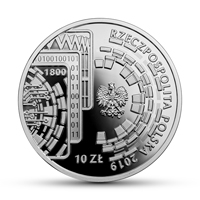
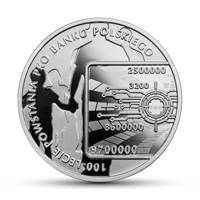
Nominał 10 zł … metal: Ag 925/1000; stempel: lustrzany;
średnica: 32,00 mm;v masa: 14,14 g; brzeg (bok): gładki;
nakład: do 20 000 szt.; Projektant monety: Dominika Karpińska-Kopiec;
Emitent: NBP; Na zlecenie NBP monety wyprodukowała Mennica Polska S.A.
Kompozycja monety to artystyczna wizja współczesnej bankowości zwróconej ku przyszłości. Uwagę przyciąga wizerunek ekranów urządzeń mobilnych, nakładających się, wielowarstwowych okien aplikacji, przechodzących między rewersem a awersem monety. Umieszczono na nich elementy nawiązujące do postępującej cyfryzacji życia społecznego, w które wpisano liczby odnoszące się do skali działania Banku. Na rewersie widnieją przenikające się postacie, symbolizujące powszechność usług Banku i jego dostępność dla milionów Polaków. Na awersie godło Rzeczypospolitej Polskiej otaczają kręgi symbolizujące świat technologii cyfrowej.
W lutym 2019 roku przypada 100-lecie powstania PKO Banku Polskiego. Historia banku rozpoczęła się 7 lutego 1919 roku, kiedy Naczelnik Państwa Józef Piłsudski, premier Ignacy Paderewski oraz minister poczty i telegrafów Hubert Linde podpisali dekret, na mocy którego powstała Pocztowa Kasa Oszczędności. Do najważniejszych zadań PKO należało m.in. zorganizowanie systemu oszczędnościowego adresowanego do najszerszych kręgów społeczeństwa, kupno i sprzedaż państwowych papierów wartościowych oraz przekazywanie środków poza granice państwa. Działania banku szybko przyniosły rezultaty i już w 1938 roku był największym depozytariuszem oszczędności w Polsce. Od początku PKO aktywnie uczestniczyła w przemianach społecznych i gospodarczych Polski, finansując kluczowe inwestycje II Rzeczypospolitej, m.in. powstanie portu i miasta Gdynia czy Centralnego Okręgu Przemysłowego. Takie zaangażowanie w realizację wielkich wyzwań społeczno-gospodarczych również współcześnie jest nie do przecenienia. Do dziś marka PKO pozostaje symbolem banku dla milionów Polaków.
PKO Bank Polski stale zwiększa skalę biznesu, a umiejętne łączenie oczekiwań klientów z wyzwaniami współczesnej bankowości umacnia jego pozycję niekwestionowanego lidera krajowego sektora bankowego. Jest silnym i nowoczesnym bankiem uniwersalnym, świadczącym usługi klientom indywidualnym, małym i średnim firmom, klientom korporacyjnym oraz inwestycyjnym. Jednym z najważniejszych elementów strategii PKO Banku Polskiego „Wspieramy rozwój Polski i Polaków” jest transformacja cyfrowa i wzrost innowacyjności usług bankowych. Działania banku pokazują, jak technologia może służyć człowiekowi i wspierać rozwój gospodarki. PKO Bank Polski wyznacza trendy na rynku. Angażuje się w perspektywiczne projekty oraz dziedziny i branże przyszłości. Jednym z ważniejszych dokonań jest zainicjowanie współpracy największych polskich banków, zakończone utworzeniem Polskiego Standardu Płatności, operatora systemu BLIK. Dzięki temu projektowi płatności dokonywane za pomocą aplikacji w smartfonie są dziś w Polsce powszechne.
PKO Bank Polski jest liderem bankowości mobilnej, a jego aplikacja IKO w ocenach użytkowników wypada najlepiej na świecie. Jako pierwszy zaadaptował technologię blockchain do potwierdzania autentyczności i niezmienności dokumentów wysyłanych drogą elektroniczną. Model biznesowy banku jest ściśle powiązany z dynamiczną cyfryzacją życia społecznego i dlatego PKO aktywnie włącza się w rozwój e-państwa. Jednym z działań było umożliwienie klientom bezpiecznego i prostego dostępu do usług administracji publicznej za pośrednictwem bankowości elektronicznej czy udział w projekcie Chmury Krajowej.Od stu lat PKO Bank Polski angażuje się w projekty, które wpływają na poprawę jakości codziennego życia milionów Polaków, a także utrwalają pamięć historyczną i tożsamość narodową. Informacja: Zbigniew Jagiełło, prezes Zarządu PKO Banku Polskiego.

100th Anniversary of PKO Bank Polski
www.nbp.pl
Narodowy Bank Polski is the central bank of the State, responsible for its monetary policy and price stability. The Bank’s functions are described in the Constitution of the Republic of Poland and the Act on NBP. NBP holds the exclusive right to issue the currency of the Republic of Poland. As the central bank, it does not provide accounts for the general public, accept deposits from or extend loans to individuals. It acts as a banker to the State budget and public sector entities. NBP also holds and manages the foreign exchange reserves of the State. Finally, it functions as a banker to banks, creating conditions for the operation of the Polish banking system. Narodowy Bank Polski is one of the most important research and analytical centres in the fields of economics and financial markets. On 24 January 2019, Narodowy Bank Polski issued into circulation a silver coin with the face value of 10 zł “100th Anniversary of PKO Bank Polski”.


Face value: 10 zł … Metal: Ag 925/1000; Finish: proof;
Diameter: 32.00 mm Weight: 14.14 g Edge (side): plain;
Mintage: up to 20,000 pcs Designer: Dominika Karpińska-Kopiec;
Issuer: NBP; The coins, commissioned by NBP, were struck
by Mennica Polska S.A.
The composition of the coin is an artistic vision of future-oriented modern banking. What attracts attention is the image of mobile device screens, with overlapping, multi-layered application windows, switching between the reverse and the obverse of the coin. They feature elements referring to the progressive digitalisation of social life, with the elements carrying numbers related to the scale of the bank’s operations. The reverse carries intertwining figures symbolising the universality of the services provided by the Bank and its accessibility to millions of Poles. The obverse features the state emblem of theRepublic of Poland surrounded by circles symbolising the world of digital technology.
February 2019 marks the 100th Anniversary of establishing PKO Bank Polski. The history of the bank started on 7 February 1919, when Józef Piłsudski, Chief of State, Ignacy Paderewski, Prime Minister, and Hubert Linde, Minister of Posts and Telegraphs, signed a decree under which the Postal Savings Bank (Pocztowa Kasa Oszczędności) was set up. The most important tasks of PKO were, amongst others, to organise a savings system addressed to the broadest spectrum of society, purchase and sell state securities and transfer funds across country borders. The bank’s operations quickly produced results and as early as 1938 it had already become the largest savings depositary in Poland. Since its establishment, PKO has been actively involved in social and economic transformations in Poland, financing key investments of the Second Republic of Poland, including, but not limited to, the establishment of the port and city of Gdynia or the Central Industrial District (Centralny Okręg Przemysłowy). Such engagement in responding to major socio-economic challenges cannot also be overrated today. Till today, the PKO brand remains the symbol of a bank to millions of Poles. PKO Bank Polski has constantly extended its business scale, with its skillful combination of client expectations and challenges of modern banking having strengthened its unchallenged position of a leader of the domestic banking sector. It is a strong and modern universal bank providing its services to individuals, small and medium-sized enterprises, as well as corporate and investment clients. One of the key elements of the strategy “We support the development of Poland and Poles” pursued by PKO Bank Polski is digital transformation and increased innovativeness of banking services.
The Bank’s operations provide an example of how technology may be at the service of man and enhance the development of the economy. PKO Bank Polski sets the trends on the market. It engages in forward-looking projects as well as the fields and sectors of the future. One of its major achievements was the establishment of cooperation between the largest Polish banks, completed by creating the Polish Payment Standard, the BLIK system operator. As a result of the project, payments effected by means of a smartphone application are now common in Poland. PKO Bank Polski is a leader in mobile banking, with its IKO application performing best in the world according to user ratings. It was the first bank to adopt blockchain technology to confirm documents submitted electronically as authentic and unaltered. The business model of the bank is closely bound up with dynamic digitalisation of social life, and PKO is, therefore, engaging in estate development. One of the activities undertaken has been to allow customers to gain safe and easy access to the services of public administration through electronic banking and to engage in the National Cloud project. For one hundred years, PKO Bank Polski has been involved in projects improving the quality of everyday life of millions of Poles and preserving the historical memory and national identity. Info: Zbigniew Jagiełło, The President of PKO Bank Polski Management Board.


Sir Alexander Mackenzie (1764 – 1820)
www.canadapost.ca
Sir Alexander Mackenzie (1764 – 1820) … The first man to cross the North American continent north of Mexico was a daring fur trader who accomplished the momentous feat eleven years before the start of the American Lewis and Clark expedition. His name was Alexander Mackenzie. Mackenzie, an employee of the North West Company, set out from northern Alberta in the spring of 1793. Accompanied by a crew of nine he travelled by canoe from the Peace to the Parsnip and the Fraser rivers, by foot to the Bella Coola, and again by canoe to Dean Channel, reaching the Pacific on July 22nd. Although Mackenzie was knighted for his efforts, he is often best remembered for another feat which he regarded as a failure. In 1789, during a first try at reaching the Pacific, he explored a river flowing west of Great Slave Lake. When it led him to the Arctic he named it River of Disappointment. Now called the Mackenzie, it is Canada’s longest waterway.

Denomination: 6¢ … Date of Issue: June 25, 1970;
Quantity: 35,500,000; Perforation or Dimension: 12;
Printer: Canadian Bank Note Company, Limited.
Historical Notice: … Alexander Mackenzie, whose trailblazing journeys place him in the forefront of North American explorers, died 150 years ago in his native Scotland. Mackenzie’s most spectacular achievement came in July, 1793 when, at the age of 29, he completed the first crossing of the North American continent north of Mexico. It was in 1774 , at the age of 10, after the death of his mother, that Mackenzie was taken by his father to New York and, in 1778, to Montreal where, one year later, he entered the service of a fur trading company. Not long after his arrival at Athabasca in 1787 he commenced planning a trip which, in 1789, was to make him the first to reach the Arctic at the mouth of the mighty river named in his honour. Bitterly disappointed at not finding the Pacific, he spent four years studying and planning before he set out through mountainous and unmapped terrain leading to the goal which he achieved years in advance of any other explorer. Impressed by the mighty volume of the Fraser River, he eventually turned westward from its course on a route which brought him to Dean Channel, a few miles from the present day community of Ocean Falls, B.C. Here, in contrast with the wooden marker he had erected at the mouth of the Mackenzie, he used a mixture of vermilion and melted grease to paint the now famous inscription on the southeast face of a rock on which his party had rested over-night.
The inscription, since chiselled on the rock face and filled with red cement, carries the simple message “Alex Mackenzie from Canada by land 22nd July 1793”. Nearby, a monument, erected by the Historic Sites and Monuments Board of Canada in 1936, bears a bronze tablet on which is printed, “This rock is the western terminus of the first journey across the continent of North America. It was made by Alexander Mackenzie of the North West Company, who, with his nine companions, arrived at this spot on the 21st July 1793. Mackenzie, by observations, ascertained his positions, spent the night here, and, after writing on the southeast face the words now cut therein, retraced his course to Lake Athabasca. This transcontinental journey preceded by more than then years that of Lewis and Clark”. Mackenzie, having accomplished his objective, wasted little time in setting out on his return trip unaware that his arrival on the Pacific coast had been within a very short time of Captain Vancouver’s survey voyage in the same general area. News of his achievements preceded his return to Britain where he was rewarded with a knighthood conferred by King George III in 1802. Later in the same year Mackenzie returned to Montreal to pursue his interest in the fur trade. From 1804 to 1808 he sat as a member of the Lower Canada Assembly, retiring in the latter year to Scotland. In 1832, subsequent to his death in 1820, his retirement home, Avoch House, was gutted in a fire which destroyed the major part of his personal relics and papers. (39-III-19)


Year of the Pig: PermanentTM Domestic stamps
www.canadapost.ca
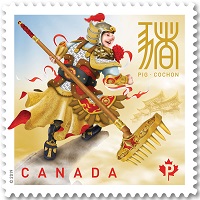
Stamp value: PermanentTM (domestic rate) …
Number of stamps included: 10; Quantity products: 270,000;
Dimensions: 32 mm x 32 mm; Issue date: January 18, 2019;
Stamp designer: Albert Ng O.Ont and Jai Paek.
Celebrate the Year of the Pig with this booklet of 10 PermanentTM domestic stamps. The design is inspired by Zhu Bajie, a colourful character from the 16th-century Chinese novel Journey to the West. Banished from a powerful position in Heaven, he is reborn into the mortal world as Pigsy, a half-human, half-pig creature. On the stamp, a proud Pigsy is clad in heavenly armour as he carries an enormous muck rake. The Year of the Pig begins February 5, 2019, and ends on January 24, 2020. While the pig is the twelfth and final animal in the Chinese Lunar calendar, this is Canada Post’s eleventh Lunar New Year issue. Our series concludes in January 2020, with the arrival of the Year of the Rat.

Stamp value: $2.65 (international rate)…
Number of stamps included: 6; Quantity products: 50,000;
Dimensions: 32 mm x 32 mm; Issue date: January 18, 2019;
Stamp designer: Albert Ng O.Ont and Jai Paek.
Year of the Pig: Booklet of 6 International stamps … Send warm wishes to welcome the Year of the Pig with this booklet of six international-rate stamps accented with gold foil. The stamp design is inspired by Zhu Bajie, a colourful character from the 16th-century Chinese novel Journey to the West. Banished from a powerful position in Heaven, he is reborn into the mortal world as Pigsy, a half-human, half-pig creature. On the stamp, a modestly dressed and seated Pigsy clutches an enormous muck rake. The Year of the Pig begins February 5, 2019, and ends on January 24, 2020. While the pig is the twelfth and final animal in the Chinese Lunar calendar, this is Canada Post’s eleventh Lunar New Year issue. Our series concludes in January 2020, with the arrival of the Year of the Rat.
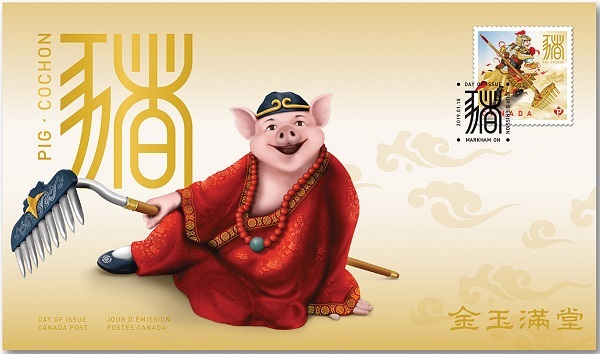
Year of the Pig: Souvenir Sheet … Honour the arrival of the Year of the Pig with this scroll-shaped souvenir sheet featuring the international-rate stamp from this issue. The stamp is accented with gold foil. This colourful collectible makes a great gift for a friend or relative born in the Year of the Pig, or for parents expecting a child this year. Stamp value: $2.65. Quantity products: 120,000.


Gardenia … PermanentTM Domestic stamps
www.canadapost.ca
Send something lovely with this booklet of 10 PermanentTM domestic stamps featuring gorgeous gardenias, this year’s Canada Post’s flower issue. The two stamp designs in this booklet feature the fragrant Cape jasmine gardenia (Gardenia jasminoides). The booklet also contains 10 matching envelope seals, a perfect finishing touch for invitations to weddings, showers and other events. With such beautiful flowers, it’s easy to see why giving gardenias was known as a way of saying ‘I think you’re lovely’ during shy Victorian times. These days, the white petals are considered a symbol of purity, making gardenias a popular choice for weddings.

Stamp value: PermanentTM (domestic rate); Art: Chantal Larocque;
Stamp designer: Andrew Conlon, Lionel Gadoury (Context Creative);
Quantity products: 800,000; Dimensions: 26 mm x 32 mm;
Issue date: February 14, 2019.
Gardenia: Souvenir Sheet … Let your love for flowers bloom with this two-stamp souvenir sheet celebrating the beauty of gardenias. This colourful collectible, part of Canada Post’s annual flower issue, includes two PermanentTM domestic stamps, both featuring different views of the fragrant Cape jasmine gardenia (Gardenia jasminoides). Quantity products: 75,000; Dimensions: 127 mm x 78 mm.

Gardenia: Official First Day Cover … Add a bouquet of beauty to any collection with this Official First Day Cover featuring gorgeous gardenias. This elegant collectible bears both PermanentTM domestic stamps from Canada Post’s annual flower issue. It’s a great gift for gardeners and nature enthusiasts of all ages. The stamps depict two distinct view of the fragrant Cape jasmine gardenia (Gardenia jasminoides), while the Official First Day cover features an enlarged version of the flower imagery from one of the stamps. The Official First Day Cover is cancelled in Flower’s Cove, Newfoundland and Labrador. Fittingly, given the gardenia’s history of romantic association, the issue date is Feb. 14, 2019. Quantity products: 7,000; Dimensions: 190 mm x 112 mm.

2019 … $3 Pure Silver Coin – Celebration of Love
www.canadapost.ca www.mint.ca
A Swarovski® celebration of love in all its many forms. Celebrate the beauty of love with an everlasting bouquet! A Swarovski® crystal puts extra sparkle on this beautiful expression of admiration and appreciation. Tied with a ribbon that resembles the infinity symbol, each rose is clad in a symbolic colour – yellow for friendship, red for romance, orange for affection—as a reminder that love blooms in many different ways. The image of love in bloom. This pure silver coin is an eye-catching celebration of the beauty of love. A sparkling expression of love. A beautiful Swarovski® crystal adds a touch of luminous elegance to the design. Colours traditionally convey emotion in a floral arrangement. On the reverse, each flower is infused with meaning thanks to the use of selective colour.

Face Value 3 dollars … Composition: 99.99% Pure Silver;
Mintage: 15,000; Weight: 7.96 g; Diameter: 27 mm;
Finish: Proof with colour; Edge: Serrated;
Artist: Anna Bucciarelli; Packaging: Premium graphic box.
Love is a passion that strikes like Cupid’s arrow, a sense of belonging that unites two souls. It is the friendships that fill our lives with happiness, magnifying our joy, and lessening our sorrow. Love is also the familial bond that nurtures, anchors, and supports us, in good times and bad. In all its many forms, a love expressed is a show of appreciation for those who matter most. Celebrate that gift of love with an everlasting bouquet. A Swarovski® crystal makes this a sparkling expression of affection. Tied with a ribbon shaped like the infinity symbol, each rose is clad in a symbolic colour—yellow for friendship, red for romance, orange for affection – as a reminder that throughout our lives, love can bloom in many different ways.
Design: Designed by Anna Bucciarelli, your coin features a bouquet of roses that form a blooming heart. Each flower is selectively coloured to represent different expressions of love: yellow for friendship and gratitude; red for romance and passion; and orange for excitement and enthusiasm. Blue accent flowers add a balancing touch of tranquility to the arrangement. Shaped like the infinity symbol, the ribbon symbolizes eternal love and is adorned with a Swarovski® crystal.

2019 … $20 Pure Silver Coin –
125th Anniversary of the Birth of Billy Bishop
www.canadapost.ca www.mint.ca
Billy Bishop … Canada’s Greatest Flying Ace. Billy Bishop was born on February 8, 1894 in Owen Sound (Ontario) to become one of the first heroes of the sky. By the end of the First World War, he had 72 victories to his credit, ranking only third behind the 80 claimed by Manfred von Richthofen, Germany’s legendary Red Baron. This coin shows Billy Bishop with his first plane that he nicknamed Little Daisy and a full-colour portrait of the great Canadian hero in the foreground. The Mint’s first coin honouring Billy Bishop, Canada’s famous flying ace of the First World War. True Canadian wartime memorabilia! This coin features archival photographs that have been meticulously reproduced as intricate engravings and a beautiful colour portrait–an innovative combination of two technologies. A must-have keepsake of a great Canadian war hero and the first Air Force recipient of the Victoria Cross. The perfect gift or collectible for history buffs, aviation, and military enthusiasts, anyone with a penchant for great Canadians and their remarkable stories.

Face Value 20 dollars … Composition: 99.99% pure silver;
Finish: Proof with colour; Mintage: 7,500; Weight: 31.39 g;
Diameter: 38 mm.
Fighter planes were all-new during the First World War. In March 1917, a young pilot who would become Canada’s top flying ace took to the air. Billy Bishop, born on February 8, 1894 in Owen Sound (Ontario), was 23 years old when he downed his first German plane on his first mission. By the end of the War, he had 72 victories to his credit, ranking only third behind the 80 claimed by Manfred von Richthofen, Germany’s legendary Red Baron. Collect our first-ever coin featuring Billy Bishop!
Design: Your coin features Billy Bishop standing with his first plane, a Nieuport 17 that he affectionately called “Little Daisy”. In the foreground, a full-colour portrait of the flying ace with “BILLY BISHOP 1894-1956” engraved to the right of his shoulder. Royal Canadian Mint engravers reproduced archival photographs to create this design. The effigy of Her Majesty Queen Elizabeth II by Susanna Blunt with “20 DOLLARS” and “ELIZABETH II D.G. REGINA” engraved along the outer edge of the coin is featured on your coin’s obverse.
Did you know… * Billy Bishop’s best-known feat is his daring solo raid of June 2, 1917. He destroyed three German planes and sent a fourth one into retreat–a victory that earned him the first Victoria Cross to ever be awarded to the Air Force. * Fighter planes of the First World War were built of canvas and wood. Top speeds were 160 KPH. It was a major achievement to fly 16 km into enemy territory. There were no parachutes on board. If a plane caught fire, it was unlikely the pilot would survive. * Billy Bishop perfected the game of “chicken.” He would fly straight at his enemy and refuse to move. Then, at the last possible moment, he would send a shower of bullets into the enemy’s engine before swerving out of the way. * In his book, Winged Warfare, Billy Bishop wrote, “It was the mud, I think, that made me take to flying.” After arriving in France, the author found himself up to his knees in mud on a stormy July day. When a plane landed and took off nearby, “I knew there was only one place to be on such a day–up above the clouds in the summer sunshine.” * Billy Bishop’s contributions continued through the Second World War. As an Honorary Air Marshal he played a key role in recruiting for the Royal Canadian Air Force and drew worldwide attention to the RCAF and to the British Commonwealth Air Training Plan.


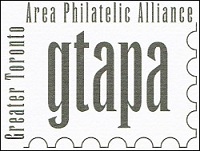
The GTAPA is committed to promote and stimulate the art of philately
to all ages for fun, culture, education, and friendship.


Royal *2019* Royale
www.rpsc.org/royal2019
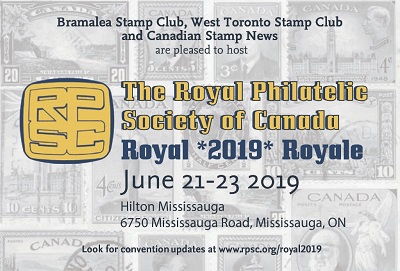
The West Toronto Stamp Club, Bramalea Stamp Club, and Canadian Stamp News are co-hosting Royal *2019* Royale. The June 21-23 convention will be held at the classy Hilton Mississauga on 6750 Mississauga Road. The next annual general meeting (AGM) of The Royal Philatelic Society of Canada (RPSC) will be held on the morning of June 22 during the society’s 91st convention in Mississauga, Ontario. The aim of the AGM, which will be held at the Hilton Mississauga/Meadowvale, is for members to receive and consider reports from executive members, directors and duty officers as well as the society’s financial statements as of Dec. 31. Members will also consider – and if approved, ratify, sanction and confirm – all by-laws, contracts, acts, and proceedings of The RPSC’s board of directors enacted since the last AGM. There will also be an election of seven directors. The 2019 election of director positions will be decided by secret ballots submitted by members of the society.

